CMOS Current Feedback Operational Amplifier-Based Relaxation Generator for Capacity to Voltage Sensor Interface
Abstract
1. Introduction
2. Readout Circuit for Capacity Measurement
2.1. The C→f0 Converter
2.2. The f0→Vsens Converter
3. Experimental Verification
4. Conclusion Remarks
Author Contributions
Funding
Acknowledgments
Conflicts of Interest
References
- De Marcellis, A.; Ferri, G. (Eds.) Physical and Chemical Sensors. In Analog Circuits and Systems for Voltage-Mode and Current-Mode Sensor Interfacing Applications; Springer: Heidelberg, Germany, 2011; pp. 1–35. ISBN 978-90-481-9827-6. [Google Scholar]
- Lee, C.; Koo, S.-M.; Oh, J.-M.; Moon, K.-S.; Lee, D. Selectable Titanium-oxide Based Critical and Differential Temperature Sensor in a Single Device. IEEE Electron Device Lett. 2018, 39, 1058–1060. [Google Scholar] [CrossRef]
- Wei, Q.; He, C.; Chen, J.; Chen, D.; Wang, J. Wireless Passive Intracranial Pressure Sensor Based on a Microfabricated Flexible Capacitor. IEEE Trans. Electron Devices 2018, 65, 2592–2600. [Google Scholar] [CrossRef]
- Rakshit, S.; Iliadis, S.A. A Novel Closed-loop Readout Topology for Monolithically Integrated Surface Acoustic Wave Sensor. IEEE Sens. J. 2013, 13, 4264–4270. [Google Scholar] [CrossRef]
- Shin, K.; Jeon, J.; West, J.E.; Moon, W. A Micro-Machined Microphone Based on a Combination of Electret and Field-Effect Transistor. Sensors 2015, 15, 20232–20249. [Google Scholar] [CrossRef] [PubMed]
- Makhotkin, V.E.; Shurukhin, B.P.; Lopatin, V.A.; Marchukov, P.Y.; Levin, Y.K. Magnetic field sensors based on amorphous ribbons. Sens. Actuators A Phys. 1991, 27, 759–762. [Google Scholar] [CrossRef]
- Vargas-Bernal, R.; Carlos, A.; Gómez-Polo, C. Electrical Circuit Modeling of Sensor Magneto-Impedances with a Square-Root Frequency Dependence. IEEE Sens. J. 2018, 18, 623–628. [Google Scholar] [CrossRef]
- Yu, X.; Chen, X.; Ding, X.; Zhao, X. A High-Stability Quartz Crystal Resonator Humidity Sensor Based on Tuning Capacitor. IEEE Trans. Instrum. Meas. 2018, 67, 715–721. [Google Scholar] [CrossRef]
- Piotto, M.; Del Cesta, S.; Bruschi, P. Precise Measurement of Gas Volumes by Means of Low-Offset MEMS Flow Sensors with uL/min Resolution. Sensors 2017, 17, 2497. [Google Scholar] [CrossRef] [PubMed]
- Zhou, X.; Yang, L.; Bian, Y.; Ma, X.; Han, N.; Chen, Y. Coupling p+n Field-Effect Transistor Circuits for Low Concentration Methane Gas Detection. Sensors 2018, 18, 787. [Google Scholar] [CrossRef] [PubMed]
- Li, H.; Parsnejad, S.; Ashoori, E.; Thompson, C.; Purcell, E.K.; Mason, A.J. Ultracompact Microwatt CMOS Current Readout with Picoampere Noise and Kilohertz Bandwidth for Biosensor Arrays. IEEE Trans. Biomed. Circ. Syst. 2018, 12, 35–46. [Google Scholar] [CrossRef] [PubMed]
- Parente, F.R.; Di Giovanni, S.; Ferri, G.; Stornelli, V.; Pennazza, G.; Santonico, M. An Analog Bootstrapped Biosignal Read-Out Circuit With Common-Mode Impedance Two-Electrode Compensation. IEEE Sens. J. 2018, 18, 2861–2869. [Google Scholar] [CrossRef]
- Haider, M.R.; Mahfouz, M.R.; Islam, S.K.; Eliza, S.A.; Qu, W.; Pritchard, E. A low-power capacitance measurement circuit with high resolution and high degree of linearity. In Proceedings of the International Midwest Symposium on Circuits and Systems (MWSCSAS), Knoxville, TN, USA, 10–13 August 2008; pp. 261–264. [Google Scholar]
- Scotti, G.; Pennissi, S.; Monsurro, P.; Trifiletti, A. 88-μA 1-MHz Stray-Insensitive CMOS Current-Mode Interface IC for Differential Capacitive Sensors. IEEE Trans. Circ. and. Syst. I 2014, 61, 1905–1916. [Google Scholar] [CrossRef]
- Ferri, G.; Parente, F.R.; Stornelli, V. Current conveyor-based differential capacitance analog interface for displacement sensing application. AEU Int. J. Electron. Commun. 2017, 81, 83–91. [Google Scholar] [CrossRef]
- Depari, A.; Sisinni, E.; Flammini, A.; Ferri, G.; Stornelli, V.; Barile, G.; Parente, F.R. Autobalancing Analog Front End for Full-Range Differential Capacitive Sensing. IEEE Trans. Instrum. Meas. 2018, 67, 885–893. [Google Scholar] [CrossRef]
- Loizou, K.; Koutroulis, E.; Zalikas, D.; Liontas, G. A low-cost capacitive sensor for water level monitoring in large-scale storage tanks. In Proceedings of the International Conference on Industrial Technology (ICIT), Seville, Spain, 17–19 March 2015; pp. 1416–1421. [Google Scholar]
- Bani-Amer, M.M. Design of Reliable and Low-Cost Capacitance-to-Voltage Converters. In Proceedings of the International Conference on Instrumentation, Measurement, Control, Circuits and Systems (IMCCAS, WSEAS), Miami, FL, USA, 21–23 April 2004. [Google Scholar]
- Huang, S.M.; Stott, A.L.; Green, R.G.; Beck, M.S. Electronic transducers for industrial measurement of low value capacitances. J. Phys. E Sci. Instrum. 1988, 21, 242–250. [Google Scholar] [CrossRef]
- Srinivasulu, A. Current conveyor based relaxation oscillator with tunable grounded resistor/capacitor. Int. J. Des. Anal. Tools Circ. Syst. 2012, 3, 1–7. [Google Scholar]
- Almashary, B.; Alhokail, H. Current-mode triangular wave generator using CCIIs. Microelectr. J 2000, 31, 239–243. [Google Scholar] [CrossRef]
- Pal, D.; Srinivasulu, A.; Pal, B.B.; Demosthenous, A.; Das, B.N. Current conveyor-based square/triangular waveform generators with improved linearity. IEEE Trans. Instrum. Meas. 2009, 58, 2174–2180. [Google Scholar] [CrossRef]
- Malik, S.; Kishore, K.; Artee, S.A.; Akbar, T.; Islam, T. A CCII-Based Relaxation Oscillator as a Versatile Interface for Resistive and Capacitive Sensors. In Proceedings of the International Conference on Signal Processing and Integrated Networks (SPIN), Noida, India, 20–21 February 2016; pp. 359–363. [Google Scholar]
- De Marcellis, A.; Ferri, G.; Mantenuto, P. A CCII-based non-inverting Schmitt trigger and its application as astable multivibrator for capacitive sensor interfacing. Int. J. Circ. Theor. Appl. 2017, 45, 1060–1076. [Google Scholar] [CrossRef]
- Sheu, M.L.; Hsu, W.H.; Tsao, L.J. A Capacitance-Ratio-Modulated Current Front-End Circuit with Pulsewidth Modulation Output for a Capacitive Sensor Interface. IEEE Trans. Instrum. Meas. 2012, 61, 447–455. [Google Scholar] [CrossRef]
- Tan, Z.; Shalmany, S.; Meijer, G.; Pertijs, M. An Energy-Efficient 15-Bit Capacitive-Sensor Interface Based on Period Modulation. IEEE J. Solid-State Circ. 2012, 47, 1703–1711. [Google Scholar] [CrossRef]
- Danneels, H.; Coddens, K.; Gielen, G. A Fully-Digital, 0.3 V, 270 nW Capacitive Sensor Interface without External References. In Proceedings of the International European Solid-State Circuits Conference (ESSCIRC), Helsinki, Finland, 12–16 September 2011; pp. 287–290. [Google Scholar]
- Beriain, A.; Gutierrez, I.; Solar, H.; Berenguer, R. 0.5 V and 0.43 pJ/bit Capacitive Sensor Interface for Passive Wireless Sensor Systems. Sensors 2015, 15, 21554–21566. [Google Scholar] [CrossRef] [PubMed]
- Lasanen, K.; Kostamovaara, J. A 1.2-V CMOS RC Oscillator for Capacitive and Resistive Sensor Applications. IEEE Trans. Instrum. Meas. 2008, 57, 2792–2800. [Google Scholar] [CrossRef]
- Abuelma’atti, M.T.; Al-Absi, M.H. A current conveyor based relaxation oscillator as versatile electronic interface for capacitive and resistive sensors. Int. J. Electron. 2005, 92, 473–477. [Google Scholar] [CrossRef]
- Chien, H.C. Square/triangular wave generator using single DO-DVCC and three grounded passive components. Am. J. Electr. Electron. Eng. 2013, 1, 32–36. [Google Scholar] [CrossRef]
- Chien, H.C. Design and implementation of relaxation generators: New application circuits of the DVCC. Int. J. Electr. 2013, 100, 227–244. [Google Scholar] [CrossRef]
- Senani, R.; Bhaskar, D.R.; Singh, V.K.; Sharma, R.K. Non-Sinusoidal Waveform Generators and Relaxation Oscillators. In Sinusoidal Oscillators and Waveform Generators using Modern Electronic Circuit Building Blocks; Senani, R., Ed.; Springer: Heidelberg, Germany, 2016; pp. 493–571. ISBN 978-3-319-23711-4. [Google Scholar]
- Senani, R.; Bhaskar, D.R.; Singh, A.K. Second Generation Controlled Current Conveyors (CCCII) and Their Application. In Current Conveyors: Variants, Applications and Hardware Implementations; Senani, R., Ed.; Springer: Heidelberg, Germany, 2015; pp. 255–314. ISBN 978-3-319-08683-5. [Google Scholar]
- Fabre, A.; Saaid, O.; Wiest, F.; Boucheron, C. High frequency applications based on a new current controlled conveyor. IEEE Trans. Circ. Syst. Fundam. Theory Appl. 1996, 43, 82–91. [Google Scholar] [CrossRef]
- Sotner, R.; Lahiri, A.; Kartci, A.; Herencsar, N.; Jerabek, J.; Vrba, K. Design of Novel Precise Quadrature Oscillators Employing ECCIIs with Electronic Control. Adv. Electr. Comput. Eng. 2013, 13, 65–72. [Google Scholar] [CrossRef]
- ON Semiconductor. I3T Process Technology. Available online: http://www.europractice-ic.com/technologies$_$AMIS$_$tech.php (accessed on 17 December 2018).
- Sotner, R.; Jerabek, J.; Prokop, R.; Kledrowetz, V.; Polak, J. A CMOS Multiplied Input Differential Difference Amplifier: A New Active Device and Its Applications. Appl. Sci. 2017, 7, 106. [Google Scholar] [CrossRef]
- Barile, G.; Ferri, G.; Parente, F.R.; Stornelli, V.; Sisinni, E.; Depari, A.; Flammini, A. A CMOS full-range linear integrated interface for differential capacitive sensor readout. Sens. Actuators A Phys. 2018, 281, 130–140. [Google Scholar] [CrossRef]

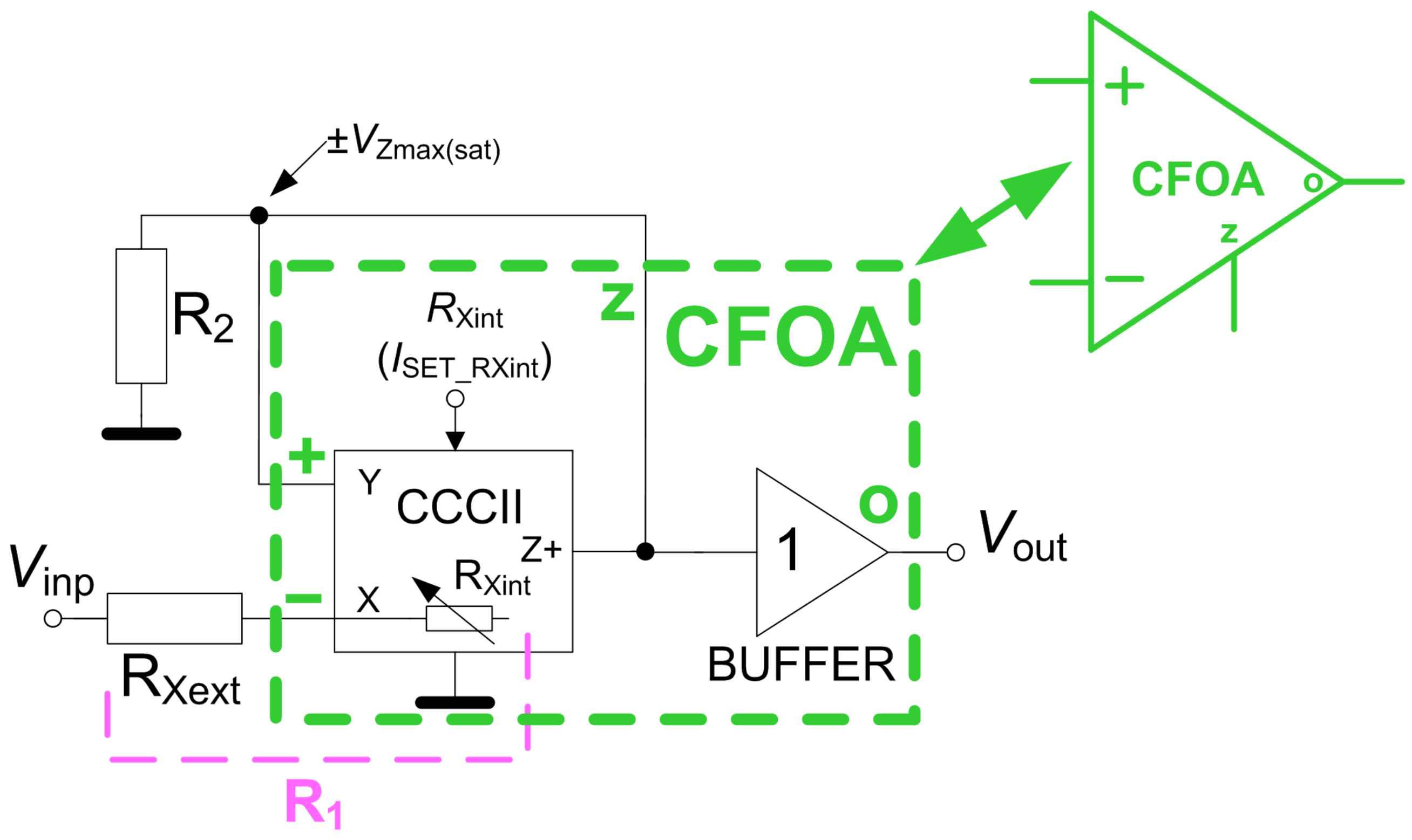

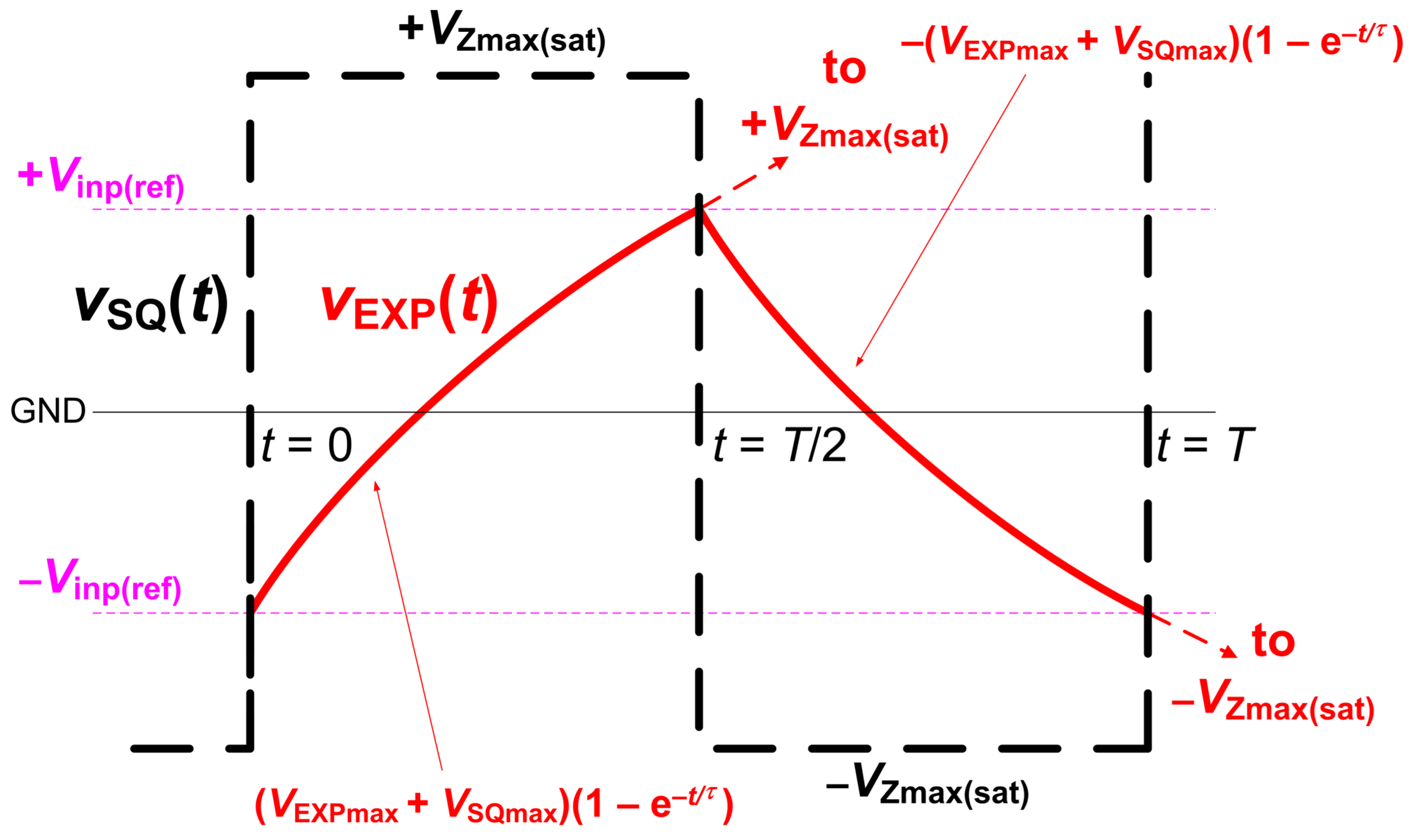



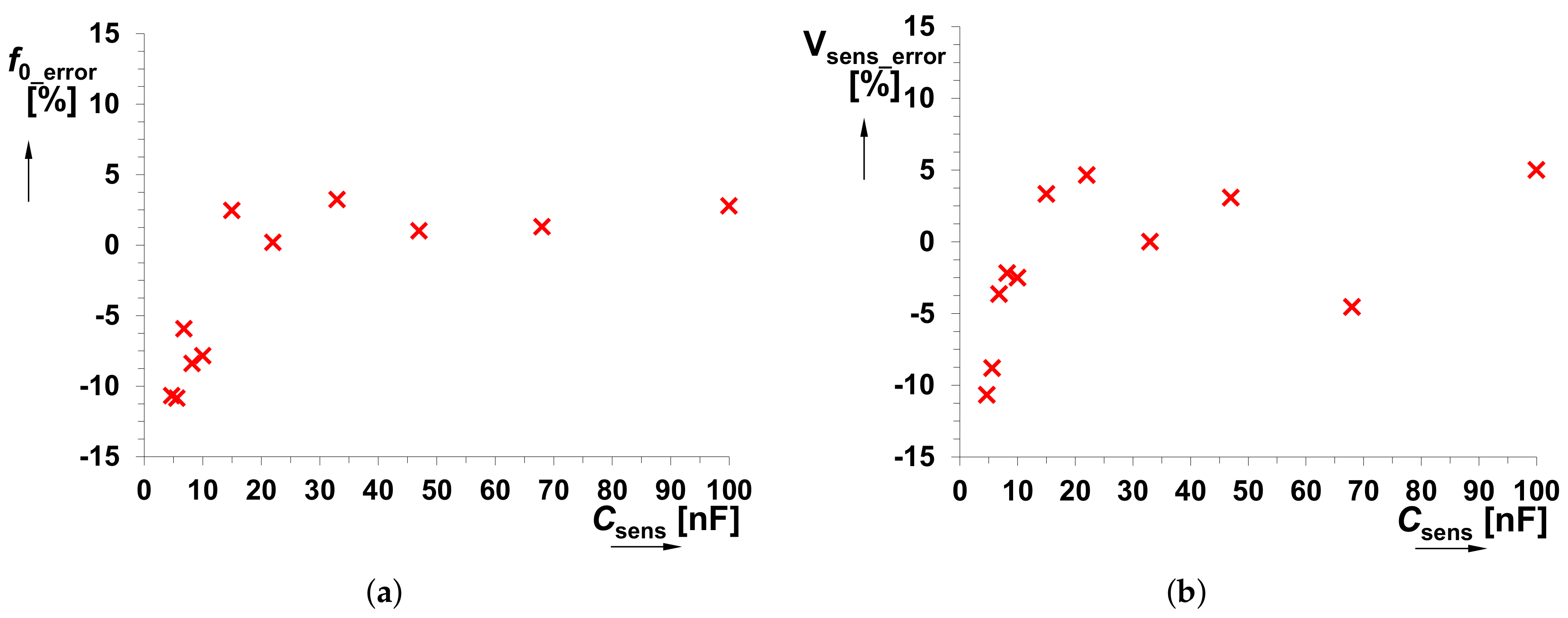
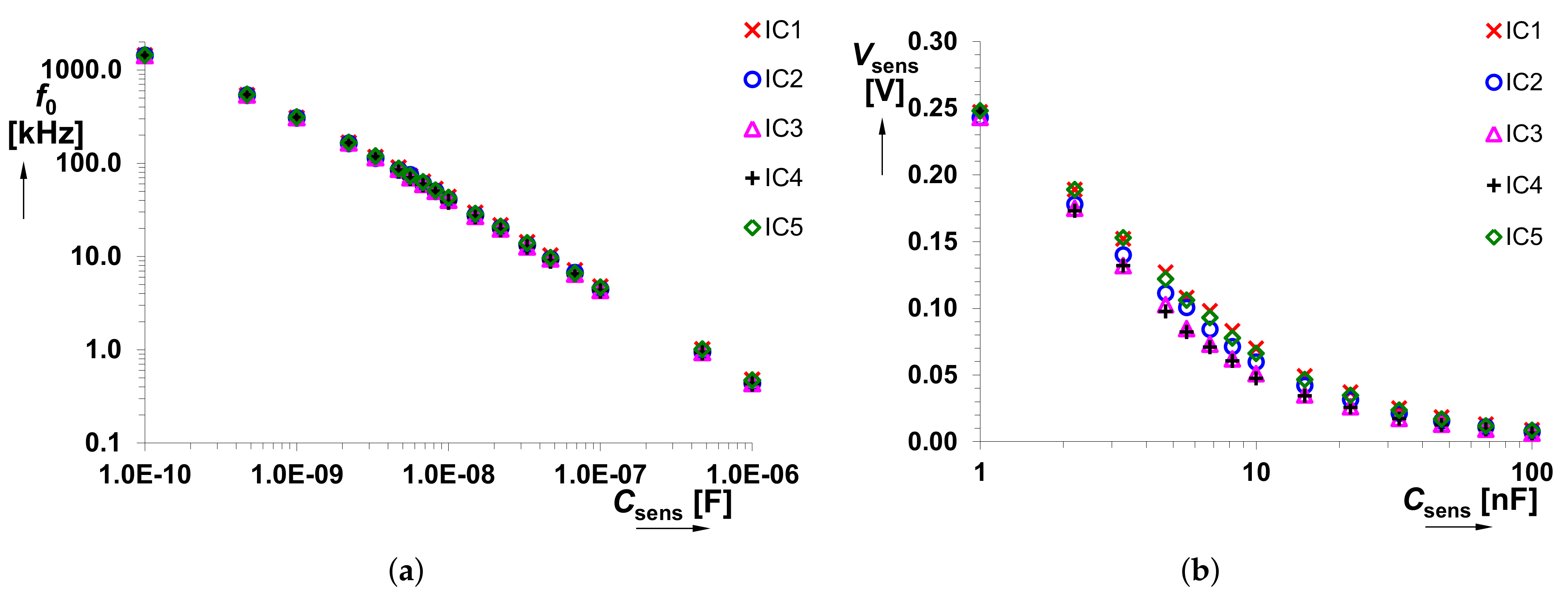
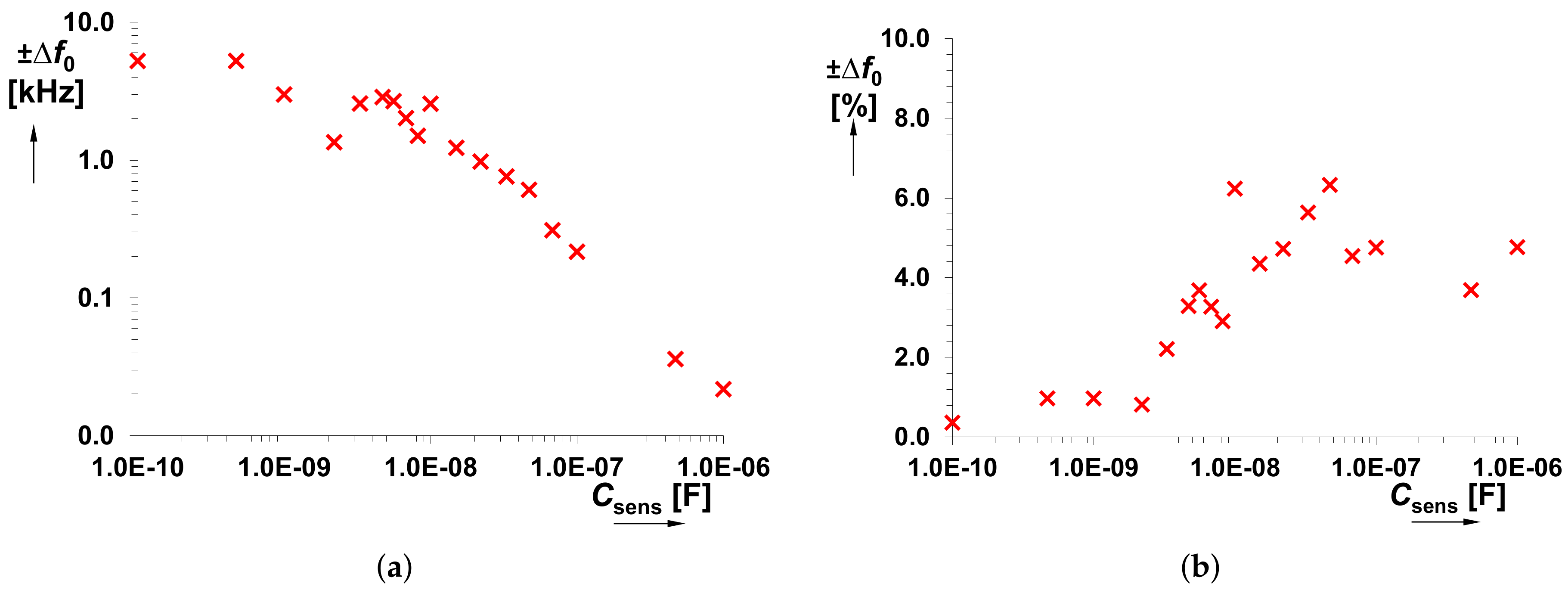


| References | Number of Active Elements | Type of Active Elements | Principle of Operation | Number of Elements (Grounded/Floating) | Type of Parameter Elements | Waveform at C | Range of Sensed Parameter | Number of Decades | Range of Read Parameter | Verification (Real Implementation of Active Device) | Integrated Solution of the Whole System | Supply Voltage | Error | Sensitivity = / Sensitivity = / |
|---|---|---|---|---|---|---|---|---|---|---|---|---|---|---|
| Differential methods | ||||||||||||||
| [14] | (b) | (b) | (b) | 6 (4/2) | Absolute difference of Cap | - | pF→+0.9 pF | - | V→+0.12 V | M (CMOS) | Yes | 2.5 V | ±1.5% | 1.33 × 10 V/F |
| [15] | 4 | CCII | I | 5 (2/3) | Relative difference of Cap | - | %→+30% | - | 2 V→11 V | M (4×AD844) | No | ±10 V | <3% | 7.54 × 10 V/m |
| [15] | 4 | CCII | I | 5 (2/3) | Relative difference of Cap | - | %→+30% | - | 0.4 V→2 V | S (CMOS) | partially | ±1.65 V | <0.23% | 1.44 × 10 V/m |
| [16] | 4 | MLT, OA | II | 8 (3/5) | Relative difference of Cap | - | %→+100% | - | V→+10 V | M (AD844, AD633, INA128, LF411) | No | N/A | ±0.8% | N/A |
| Square waveform generating circuit-based methods | ||||||||||||||
| [30] | 1 | CCII | III | 3 (2/1) | Cap | E | 100 pF→700 pF | <1 | 441 kHz→346 kHz | M (AD844) | No | ±10 V | N/A | 1.6 × 10 Hz/F |
| [20] | 3 | CCII | III | 6 (5/1) | Cap | T | 500 pF→5 F | 4 | 150 kHz→15 Hz | B (CMOS, 3×AD844) | No | ±6 V | N/A | 3 × 10 Hz/F |
| [31] | 1 | DO-DVCC | III | 3 (3/0) | Cap | T | 125 pF→10 nF | <2 | 800 kHz→10 kHz | M (5×AD844) | No | ±10 V | N/A | 8 × 10 Hz/F |
| [32] | 1 | DVCC | III | 3 (2/1) | Cap | E | 1 nF→1 F | 3 | 10 kHz→10 Hz | M (3×AD844) | No | ±15 V | N/A | 1 × 10 Hz/F |
| [21] | 2 | CCII | III | 5 (4/1) | Cap | T | 10 nF→20 F | <4 | 410 kHz→260 Hz | M (2×AD844) | No | N/A | N/A | 2.1 × 10 Hz/F |
| [22] | 2 | CCII | III | 5 (1/4) | Cap | T | 0.5 nF→10 F | <5 | 263 kHz→25 Hz | M (2×AD844) | No | (±5–±15) V | <5% | 2.6 × 10 Hz/F |
| [24] | 1 | CCII | III | 4 (1/3) | Cap | E | 100 pF→5.5 F | <5 | 6.9 kHz→0.14 Hz | M (AD844) | No | N/A | ≤±10% | 1.3 × 10 Hz/F |
| [24] | 1 | CCII | III | 4 (1/3) | Cap | E | 22 pF→5.5 F | <6 | 232 kHz→1 Hz | S (CMOS) | partially | ±1.2 V | ≤±10% | 4.2 × 10 Hz/F |
| [23] | 2 | CCII | III | 4 (3/1) | Cap | T | 500 pF→200 nF | <3 | 39 kHz→98 Hz | M (2×AD844) | No | ±9 V | <7% | 2 × 10 Hz/F |
| Proposed (C→fconversion) | ||||||||||||||
| This work | 1 | CFOA | III | 4 (2/2) | Cap | E | 4.7 nF→470 nF 6.8 nF→100 nF | 3 <2 | 89.3 kHz→1.1 kHz 74.8 kHz→4.8 kHz | M (CMOS CCCII, buffer) | partially | ±1.65 V | <±11% <±6% | 1.9 × 10 Hz/F 7.5 × 10 Hz/F |
| Proposed (C→V conversion) | ||||||||||||||
| This work | 1 | CFOA | III | 10 (5/5) | Cap | E | 4.7 nF→470 nF 6.8 nF→100 nF | 3 <2 | 0.134 V→0.019 V 0.106 V→0.021 V | M (CMOS CCCII, buffer, diodes) | partially | ±1.65 V | <±12% <±5% | 247 × 10 V/F 912 × 10 V/F |
| C [nF] | f [kHz] | f [kHz] | Error (m versus i) [%] | V [V] | V [V] | V [mV] | V [mV] | V [mV] | Error (m versus s) [%] |
|---|---|---|---|---|---|---|---|---|---|
| 4.70 | 100.0 | 89.3 | 1.70 | 3.08 | 170 | 150 | 134 | ||
| 5.60 | 83.9 | 74.8 | 1.72 | 3.04 | 143 | 125 | 114 | ||
| 6.80 | 69.1 | 65.0 | 1.70 | 3.06 | 118 | 110 | 106 | ||
| 8.20 | 57.3 | 52.5 | 1.70 | 3.08 | 97 | 92 | 90 | ||
| 10.0 | 47.0 | 43.3 | 1.70 | 3.06 | 79 | 80 | 78 | ||
| 15.0 | 31.3 | 32.1 | 1.66 | 3.06 | 53 | 60 | 62 | ||
| 22.0 | 21.4 | 21.4 | 1.68 | 3.04 | 36 | 43 | 45 | ||
| 33.0 | 14.2 | 14.7 | 1.66 | 3.06 | 24 | 34 | 34 | 0.0 | |
| 47.0 | 10.0 | 10.1 | 1.66 | 3.04 | 17 | 26 | 27 | ||
| 68.0 | 6.9 | 7.0 | 1.64 | 3.06 | 12 | 22 | 21 | ||
| 100.0 | 4.7 | 4.8 | 1.64 | 3.04 | 8 | 20 | 21 | ||
| 470.0 | 1.0 | 1.1 | 1.60 | 3.06 | 2 | 17 | 19 |
© 2018 by the authors. Licensee MDPI, Basel, Switzerland. This article is an open access article distributed under the terms and conditions of the Creative Commons Attribution (CC BY) license (http://creativecommons.org/licenses/by/4.0/).
Share and Cite
Polak, L.; Sotner, R.; Petrzela, J.; Jerabek, J. CMOS Current Feedback Operational Amplifier-Based Relaxation Generator for Capacity to Voltage Sensor Interface. Sensors 2018, 18, 4488. https://doi.org/10.3390/s18124488
Polak L, Sotner R, Petrzela J, Jerabek J. CMOS Current Feedback Operational Amplifier-Based Relaxation Generator for Capacity to Voltage Sensor Interface. Sensors. 2018; 18(12):4488. https://doi.org/10.3390/s18124488
Chicago/Turabian StylePolak, Ladislav, Roman Sotner, Jiri Petrzela, and Jan Jerabek. 2018. "CMOS Current Feedback Operational Amplifier-Based Relaxation Generator for Capacity to Voltage Sensor Interface" Sensors 18, no. 12: 4488. https://doi.org/10.3390/s18124488
APA StylePolak, L., Sotner, R., Petrzela, J., & Jerabek, J. (2018). CMOS Current Feedback Operational Amplifier-Based Relaxation Generator for Capacity to Voltage Sensor Interface. Sensors, 18(12), 4488. https://doi.org/10.3390/s18124488






